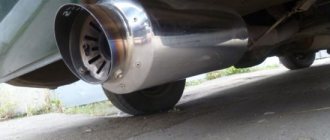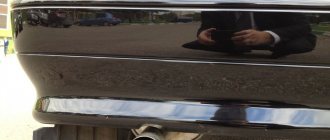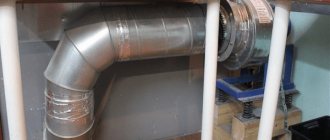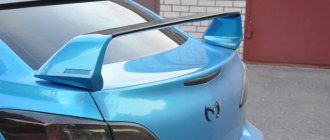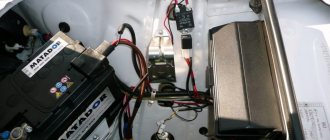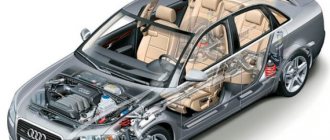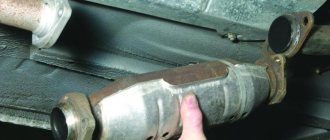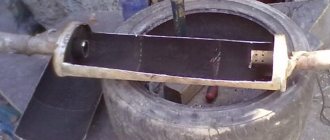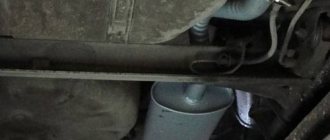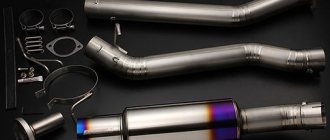Many car owners are interested in whether it is possible to make their too noisy car quieter on their own. A very small number of car enthusiasts are satisfied with the deafening sports exhausts of a running car. For all people, the degree of convenience is very important.
Driving by car can only be enjoyable if you hear as little extraneous and unpleasant sounds as possible inside the car. Also, when traveling by car, it is not safe for the driver to switch to untimely loud sounds - this can lead to an accident. In addition, too loud sounds emanating from the car can cause dissatisfaction with the people around you.
The muffler creates its own background noise, which can be greatly reduced. The result is always very good.
It must be said that here there is information only about a typical exhaust system and muffler. The direct-flow system is not considered. Always remember that both systems are very different from each other. It should also be noted that information is not provided here about the method by which the internal structure of the muffler is rebuilt, a lot of welding work is carried out, etc. This article presents the most popular, accessible and simple methods.
Direct flow with damper
To make a quiet direct-flow muffler, but not lose the additional power that modernization of the exhaust tract gives, use a direct-flow muffler with a damper. This exhaust design has been known for a long time and is found on many BMW models (usually with manual transmission).
When the engine is running at low settings, when the advantage of the coordinated exhaust is not taken advantage of, the exhaust gases exit through a conventional muffler, and the direct-flow muffler is closed with a damper. At optimal speeds, the damper opens the outlet into forward flow, and the motor produces maximum torque due to enhanced ventilation of the cylinders.
The damper control is automatic, but there are also manual models. In the city, such a car sounds almost no different from a stock one, and on the highway it not only sounds like a tuner, but has a real increase in power. It’s not cheap - for a full automatic machine, complete with a titanium “spider”, the price often exceeds a couple of thousand dollars.
Similar in capabilities, but not very famous analogues are moderately expensive, but it is better to select a suitable option with a specialist - the success of such an upgrade may require the knowledge of a motor engineer.
A budget option for direct flow with a damper can also be welded yourself from scrap materials. The upper part from an old carburetor will be suitable for the damper, if you bring the idle speed cable into the cabin. Making such a design with your own hands will take much more effort and time than for a homemade flute, and the result of the installation cannot be predicted in advance. It's not difficult to mute the sound, but to maintain power, even if you're lucky, you'll have to tinker with the settings.
What is a flute in a direct-flow muffler, and what is its effect?
To make the forward flow quieter and get “passing” decibels at the output, a simple design is used, which motorists call a flute. This is a piece of perforated tube with a length of 180–250 mm and a diameter of slightly more than 1/3 of the exhaust, with a welded plug washer in the form of a disk, cylinder or cone, which is bolted inside the forward flow, at the air cut, thereby allowing it to be muffled.
The principle of operation of the flute for direct flow is that when the cross-section of the exhaust channel changes and exhaust gases exit through the perforations, the following occurs:
- change in speed and pressure;
- the sound wave breaks;
- the volume decreases by 3-4 dB, the exhaust becomes quieter.
The correct name for this flute is silencer (from the English silencer - muffler), and it is included in the set of expensive exhaust systems that are sold on the Internet. You can also purchase separately, the average price of good European models is 70–150 dollars, and mass ones from the Middle Kingdom - from 450 rubles.
How to make the quietest muffler for a car yourself?
When the issue with noise during car operation has gone too far, and you have decided to make the quietest muffler for the car, then you need to start by preparing the tool. We will need:
- welding machine, an inverter or semi-automatic will do;
- angle grinder and discs for it;
- workbench with a vice.
The surest and most inexpensive way to make a muffler quieter is to weld in an additional resonator. This can be done in a garage yourself.
An additional resonator can be placed between the standard resonator and the muffler. You can install a ready-made resonator; you just need to weld it into the desired place in the pipe. Or you can assemble the resonator yourself. For those who doubt whether the exhaust will become quieter if an additional resonator is welded in, the answer is clear - the exhaust will become quieter. If everything is done correctly.
Possible inconveniences associated with a quiet muffler
The car will now be quieter, which is what we wanted to achieve, but there may be some disadvantages - an increase in the overall weight of the exhaust system. Therefore, it is necessary to hang stronger brackets so that the exhaust pipe does not come off on rough roads. There are also cases when rubber shock absorbers are hung. But in fact, a homemade resonator will weigh about 2-3 kg.
It is also necessary to test in action how the exhaust system works so that gases exit normally through the exhaust pipe. Therefore, it is necessary to check at higher speeds, then it will be possible to draw the right conclusions. But as a rule, gases will escape through such a resonator without difficulty.
And then in the video there is another way to reduce the sound of the muffler, making a really very quiet exhaust system:
Source
What to do?
If you are faced with a problem such as ringing after removing the catalytic converter, then you should resort to the following actions:
- Carry out a complete diagnostic of the exhaust system to ensure that its parts are in good condition.
- Inspect the exhaust system, as damaged sections of the exhaust route may be detected
- Listen to the muffler ringing. Sometimes specialists can determine the cause of the ringing after they listen.
Don't put off solving a problem like a ringing muffler. At first glance, this problem does not cause serious concern, but it can lead to serious problems in the car.
Ease of execution
What is the simplest silencer, both factory-made and home-made? One of my friends, who needed to deregister his Accord for sale (without undergoing maintenance), encountered a similar problem: he had a homemade direct flow installed. So he solved the problem in a matter of hours by visiting some welders he knew and welding a sheet of metal onto the pipe. The entire procedure for creating the insert took about an hour. Then all that’s left is to drill it, fasten it with a couple of bolts, and it’s done, you can go to the traffic police.
Another friend built a silencer out of a coffee can: it was both inexpensive and functional. But for those who want to do everything according to the rules, observing certain aesthetic principles in creating tuning for their pet, we will provide step-by-step instructions for making a simple silencer.
Why does the exhaust system make loud noises?
To understand the reason for the appearance of loud sounds, you need to know the principle of operation of a standard exhaust system and the loads it is subjected to during operation. Temperature changes (cold and heat), contact with moisture, dirt and dust - all this provokes the development of corrosion. After some time, sections of pipes with perforations and those parts of the partitions that are located inside the muffler can burn out. Sound reflectors are gradually becoming unusable. In especially difficult cases, only one thing can save you from a loud exhaust system - replacing the old muffler with a new one.
Where do loud noises come from in the exhaust structure? They have different origins. Firstly, these are sounds from the expansion of gases that pass through it. Secondly, there is noise caused by vibration of exhaust components.
Source
Causes of loud exhaust
In all combustion chambers, processes occurring with the pistons located in the cylinder are necessarily accompanied by small explosions. The volume of gas instantly increases, which provokes the movement of the pistons downward. The exhaust valve then opens and a wave of gas enters the expansion of the exhaust device.
Too much noise comes from powerful mechanical vibrations in the exhaust gas outlet device. Very large expansions can contribute to loud noise. As a result, all components of the exhaust device are made of very dense and durable metal - it helps reduce noise and vibration.
A loud exhaust may be the result of a malfunction of the muffler, catalytic converter, or other parts of the exhaust system. If you are not sure that the exhaust system is in order, it is better to contact a car repair shop. However, you can try to find the cause yourself and, for example, if the old muffler or resonator is to blame, then you can replace them yourself.
We make direct flow from scratch
To do this you will need to use the services of a turner. We order two pipes:
- One made of steel 2 mm thick with a diameter of 130 mm and a length of 42 mm.
- The second is made of steel with a thickness of 2.5 mm, a diameter of 52 mm and a length of 42 mm with holes with a diameter of 8-10 mm, every 2 cm;
Two flanges with a diameter of 130 mm with an internal hole of 52 mm, metal thickness 2-2.5 mm can be ordered separately.
Prepared:
- Asbestos rope;
- Glass wool or mineral wool.
Asbestos rope is wrapped around the inner pipe. This is done in order to protect the mineral wool, which will be the top layer, from overheating.
We fill the top layer, assemble and scald the structure. We weld the fasteners and attach the forward flow to its regular place. For beauty, you can put a muffler attachment on it.
Another design of the device is shown below.
Blueprints
There are a lot of ways to make a direct-flow muffler; the main thing here is to understand the principle of operation of the device and use your imagination. And for car owners who find it difficult to do this, use the methods and drawings described above, they are simple and accessible to many.
What is required to build an ASG (direct-flow exhaust system): tuning kit
Undoubtedly, installing a PG is a tuning, a modernization. And everything you need to build such a sporty exhaust option is available in stores.
The first is the resonator. Note that the sports PG does not have partitions that prevent the escape of gases. Its entire design is aimed only at ridding the internal combustion engine of excess gases generated during fuel combustion. As a result, power increases due to increased airflow.
Interesting point. On cars equipped with a naturally aspirated internal combustion engine, installing a sports PG allows you to increase power by 10 percent of the standard power, and on turbocharged cars - by 20 percent or even more.
The second necessary element, of course, is a new direct-flow flame arrester. The universal damper is intended as an alternative to the standard catalyst when constructing a direct flow. Such an element must be made of stainless steel (there is an option of aluminized steel). The internal part of such a flame arrester has a universal design, designed to increase the power of the machine’s power unit.
The structure of the muffler in the form of a diagram gives a complete picture of it
Fastening elements and other accessories, which must include various adapters, adapters, flanges, thermal tape for the exhaust manifold, etc., are also part of the system.
And finally, the muffler pipe, made of stainless steel or aluminized. The pipe itself must have an increased diameter (usually in the range of 38–76 mm). The length of the pipe is about 1000 mm, the wall thickness is 1.5 mm.
Firmware for EURO2 and snag – what does this mean?
As I wrote above, the second oxygen sensor (lower lambda) controls harmful emissions. Their number is now strictly regulated by European standards, which are called “EURO”; I will not talk about EURO “0-1” now; we are interested in the second generation.
So, what is EURO2? It was introduced a long time ago, namely in 1996. AT that time, the cars received an innovative system, namely a catalyst. As we all know, over time it can become clogged, and the fuel then was not the same as now, it had a lot of sulfur, which contributed to the honeycombs clogging much faster, and as you and I know, the car began to choke itself. Then the engineers installed an oxygen sensor, there was only one, and it was needed to capture CO2 in the chamber in front of the catalytic converter.
If the CO2 level increased, this indirectly indicated that the catalyst was clogged (that is, a backpressure effect was manifested); the sensor sent this information to the ECU and the ignition was adjusted, namely, a decrease in the supply of the fuel mixture. Thus, the power dropped significantly, the car did not drive and the owner “willy-nilly” had to go to a service station and change this spare part.
But how? YES, everything is simple, the CO2 level in the chamber in front of the neutralizer dropped significantly, the oxygen sensor recorded this (that everything is in order) and the car drove cheerfully and without constraint. This suited everyone, BUT NOT ECOLOGISTS! Therefore, they introduced the EURO3 standard (now the EURO5 standard already exists). What has changed is that a second oxygen sensor (lower lambda) just appeared behind the catalyst. The principle of operation here is this: the first lambda (before the filter) records the level of harmful substances, the second (after it) should record a much lower level, because the harmful substances have decomposed.
What is done with firmware for EURO2? The firmware in the ECU is changed, instead of EURO3.4 standards, EURO2 standards are installed. The essence of all these actions is banal - we simply turn off the second lower lambda (only the upper one remains), the car begins to drive as expected, without underestimating the power.
But such interventions in the firmware are not entirely good. The whole point is that they don’t produce them themselves, okay, the second “lambda” is simply turned off, that is, they simply adjust the readings. Or maybe this programmer will want to put some incomprehensible algorithms into the ECU, the engine will definitely not benefit from this. You need to be very careful here.
Therefore, we found a second solution, and I think it is more correct - installing a blende. What is a snag - essentially it is a “spacer” in front of the second oxygen sensor, it seems to move it a greater distance from the exhaust gases, it detects more oxygen and starts working normally.
Now there are several options for deception:
- Empty. It's just a tube with a very thin hole at the end (the part that screws into the muffler), and an oxygen sensor is screwed into the other side. A limited amount of harmful substances from the exhaust passes through it, there are no excesses and therefore CHECK does not burn.
- With a mini catalyst inside. That is, right in the “spacer” there are, as it were, mini honeycombs, which also clean the exhaust precisely to record normal values.
- Angular. These are both of the types described above, only they are made at an angle of 90 degrees; they are needed for difficult places.
The advantages of the decoy are that you don’t need to go into the ECU and change the standard firmware, as well as the price (knocked out the cells, screwed on the decoy and that’s it, you can spend 3,000 - 5,000 rubles).
Is it possible to avoid a fine?
It is not a fact that you will be able to avoid punishment, but you can try. First of all, the motorist must assume a guilty look and ask for the minimum penalty provided for by law (Articles 12.5 and 8.23 of the Administrative Code) - a warning. You can assure the inspector that the cause of the violation will be immediately eliminated, and the problem itself arose quite recently. It will be a plus if, when checking the fines, it turns out that the driver is not registered with them.
If the representative of the State Traffic Inspectorate is not influenced by any convictions, you can simply agree to the fine and pay it on time - then only 250 rubles will be collected from the driver in favor of the state.
Making a car muffler quieter
To begin the fight against excessive car noise, launch an offensive on all fronts. Before you take decisive action, you must clearly understand the operation of the exhaust system of your car engine. After all, the engine and exhaust system are balanced with each other so as not to interfere with each other’s work. And a violation of this balance can lead to improper engine operation.
Use the simplest method to reduce noise - install a “can” (as car enthusiasts call an additional final muffler). It is made of a housing through which a pipe with holes passes. The body is filled with heat-resistant fiber filler, secured with a fine mesh. It is installed between the catalyst and the standard muffler.
Cut the section of pipe between the catalyst and the muffler to the required length, corresponding to the length of the “can.” Remove the muffler. Install and attach the “can” to the resonator, using clamps and sheet asbestos to seal the joint.
Install the muffler in its original place, joining it to the “can,” using, again, clamps and sheet asbestos to seal the joint. When installing a “can” or final muffler, it is necessary to carefully seal the pipe joints with heat-resistant asbestos in order to prevent breakthrough of exhaust gases, which will create an increased noise level.
An additional effect in reducing noise will be obtained by replacing the resonator installed on the car by the manufacturer with the same “can” with a heat-resistant filler. Replacing the standard resonator can be done using the same method.
Another way you can try to suppress noise is to replace the exhaust manifold with a specially designed manifold. Unfortunately, this method is associated with the difficulty of acquiring such spare parts for certain brands of cars. These are the main ways to make a quiet muffler for a car. If you know others, we are happy to welcome your comments.
Forward flow is an opportunity to increase the power of a car’s engine, add aggressiveness to the car and improve jerkiness. You can assemble and install it yourself by studying the step-by-step instructions.
Noise standards and liability for exceeding them
Responsibility for loud exhaust from a muffler is provided for under Article 8.23 of the Code of Administrative Offenses. The driver is charged for operating a vehicle with excess noise levels in accordance with the Technical Regulations of the Customs Union 018/2011 “On the safety of wheeled vehicles”, paragraph 9.9.
Table: dependence of the maximum permissible sound level on the vehicle category
| Vehicle category | Sound level (in decibels) |
| M1, N1, L | 96 |
| M2, N2 | 98 |
| M3, N3 | 100 |
Category M1, N1 and L are passenger cars with no more than 8 seats, trucks with a permissible maximum weight of no more than 3.5 tons, motorcycles/mopeds/ATVs. Category M2 and N2 are cars with more than 8 seats (except for the driver), but whose maximum weight does not exceed 5 tons, and trucks with a permissible maximum weight from 3.5 to 12 tons, respectively. Category M3 and N3 are full-fledged buses and trucks with a permissible maximum weight of more than 12 tons (trucks, most dump trucks).
According to 12.5.1 of the Code of Administrative Offenses, the driver (or owner) is charged for making changes to the design of the car without the permission of the supervisory authority - the traffic police.
So, the fine for a straight-through muffler can be either a warning plus a fine of 500 rubles, or two fines of 500 rubles each (in practice, two warnings cannot be issued).
The manufacture of a direct-flow muffler and its further improvement is within the power of most car enthusiasts. Despite the restrictions on the operation of such devices in our society, there are more and more people who want to make their own and install a direct-flow muffler on a car. Thanks to detailed instructions with photographs and videos, it will be much easier to make a forward flow.
Do-it-yourself welding of a new resonator
This is not a difficult task.
It is necessary to make the resonator body from steel, produced in the form of sheets, then weld the partitions, and also insert pipes with holes. It is necessary to place mineral basalt wool into the resonator cavity, and then weld the end. For a car with an engine capacity of 1600 cc. cm, a pipe with a diameter of 52 mm is sufficient. After welding is completed, the seams are processed. You need to paint the resonator with heat-resistant paint. Before installing the exhaust system elements, you should take a closer look at the pipes between the muffler and the resonator. In bends, the aggressive influence of exhaust gases increases, which is why burnouts may occur. It is necessary to brew them if found.
Upon completion of the above work, the exhaust system is assembled and attached.
The most important thing is the installation of gaskets. After this, the problem will be eliminated for a certain period of time.
The vehicle and exhaust system parts should be inspected from time to time. Fasteners and suspension require the most attention. Vibration worsens the rigidity of connections.
Professionals recommend introducing an anti-corrosion mixture into the muffler before installation. As a result, it is possible to extend the operating time of the vehicle.
How to make a quiet muffler on a car - tuning the silence
Only a small part of car enthusiasts would like to have a loud sports exhaust on their car. The vast majority of drivers, on the contrary, are puzzled by the question of how to make a quiet muffler. Driving can be comfortable only if as little extraneous sounds as possible enter the cabin. The muffler creates its own background noise, which can be significantly reduced. The effect of this cannot be ignored.
Basic ways to make a muffler quieter
Before you begin upgrading your exhaust system, you should understand the nature of the increased exhaust sound. With each working stroke of the piston, a micro-explosion occurs in the combustion chamber of the engine cylinder, which is accompanied by a significant sharp expansion of gases. Naturally, a kind of blast wave, after it has done its job and moved the piston down, rushes through the exhaust system with the opening of the exhaust valve.
Thus, the nature of exhaust system noise is twofold:
- sound from expansion of gases;
- noise from vibration of exhaust system elements.
As you know, the main way to combat noise is to increase the weight of the elements. The thicker the metal, the less vibration and, accordingly, noise. That is why the exhaust manifold, which is the first to absorb hot gases from the cylinder head, is made so massive. Many car enthusiasts who had the opportunity to compare the weight of the exhaust pipe of a domestic car and a foreign one noted that the exhaust system parts of foreign cars are much heavier. This is why “our” cars are less comfortable in sound and noise comparisons.
Special elements are designed to reduce the speed of gas movement in the exhaust pipe: resonators and mufflers. First in line is the resonator. As soon as gases under pressure enter a part of the pipe with an increased volume, they immediately lose some of their energy and move further with less momentum. In the muffler labyrinth system, the exhaust gases finally lose their energy and are dissipated. A real quiet muffler on a foreign car is quite heavy and has several separate housings.
Do-it-yourself quiet muffler, video:
Making a quiet muffler with your own hands
When starting to modernize the exhaust system in order to reduce exhaust sound, you should be prepared technically and financially. For work you will need a full set of car mechanic tools. In addition, you will definitely need:
- welding machine (preferably semi-automatic or inverter);
- angle grinder with a set of discs;
- a workbench equipped with a vice.
There are also two options for upgrading the exhaust system: installing an additional factory-made resonator in the area between the main resonator and the muffler, or making the device yourself.
When considering how to make a muffler quieter, you should keep in mind that either option may entail different costs. If the car enthusiast is not limited by budget, then you can safely buy a new resonator, cut out part of the pipe and weld it into the free space. The second method turns out to be more exciting and should be described in more detail.
The manufacturing technology of an additional resonator consists of the following stages:
- manufacturing a body (barrel) from a piece of thin-walled steel pipe or sheet steel in the form of two halves;
- making holes in a section of the exhaust system pipe corresponding to the length of the body behind the main resonator;
- connecting the body halves on a pipe with holes and scalding;
- laying basalt mineral wool into the cavity of the new body;
- welding of the end parts of the resonator.
Finally, the welds should be processed, the new resonator should be cleaned and degreased, and if possible, painted with heat-resistant paint.
Video, what is an exhaust manifold and resonator?
Additional problems of a quiet car
Once the question of how to make a quiet muffler has been resolved, some problem areas become apparent. First of all, it should be remembered that any of the methods for producing a “quiet” exhaust system will certainly lead to an increase in the weight of the structure.
This, in turn, obliges the car owner to take additional measures to strengthen the brackets and rubber shock absorbers. Another point to consider is the change in the balance of air entering the engine and exhaust gases. After upgrading the exhaust system, it is imperative to test the operation of the engine in different modes and make additional adjustments to the fuel supply and air filtration system.
Ways to muffle the exhaust sound
Before tuning the exhaust system, you need to understand the reasons why the sound of the engine becomes louder over time. The operation of the engine itself is a fairly loud process, but the muffler and other components of the exhaust system perfectly suppress this loud noise. Without a muffler, the engine noise is very loud.
The noise occurs because the fuel mixture explodes in the combustion chamber, releasing gases that then exit into the exhaust pipe. We will not talk in detail about the operation of the engine, you can read about this in another article, but here we will talk specifically about how to muffle the exhaust sound.
The explosion releases energy that pushes the piston, and when the piston has moved the required distance, the exhaust valve opens, through which the exhaust gases exit and go further through the exhaust system. To effectively absorb noise, thick metal parts are used. So, the thicker the metal used in the exhaust system, the quieter the car will drive due to the fact that there will be less vibration.
The exhaust manifold is the first one to absorb the noise, which is why it is made so large and thick, so it best dampens the noise that comes from the cylinder block. Even if you compare the exhaust pipe of any more or less normal foreign car with the exhaust pipe of a domestic car, you can see that in foreign cars the pipe is heavier and thicker, which is why such a car runs quieter.
This is why when you drive an old VAZ 2114, the noise is such that you can’t hear what the passengers in the rear seats are saying, which is why you start thinking about how to muffle the exhaust sound.
The exhaust system also has a resonator, which is needed to reduce the speed of gases through the exhaust pipe. And after the resonator comes a muffler. When exhaust gases pass through the resonator, they lose some energy and continue to flow more slowly.
Gases lose the largest share of their energy in the muffler. If we consider a good muffler, then it contains several separate housings, after passing through which little remains of the noise.
How to make an additional muffler resonator with your own hands
Making a muffler resonator with your own hands is quite simple; now we will discuss each step in detail. First you need to make an outer casing, it can be made from any steel pipe with thin walls: which looks like this:
Then you need to take perforated iron with a thickness of 4.5 mm. This is enough to insert it into the end part, as in the photo below:
Next, you need to fill the resonator with something; ordinary tin sponges are perfect for this purpose.
Then you need to pull the resonator body onto these washcloths, as in the photo:
Then you need to take rivets and rivet the entire structure, so you don’t even need to weld it, like this:
For those who like to cook, you can also brew the end parts to the central part.
When everything is ready, you need to process the seams and you can paint them with heat-resistant paint, and after that the quietest muffler on your car is ready.
Installation of forward flow at a service center
Have you found out how to make the exhaust sound bassy (perhaps you found additional information on thematic motorist forums), but are not ready for tuning yourself or do not have the technical ability to do it? We recommend contacting specialists - a service center. We will carry out the necessary work on dismantling and installing direct flow in the car. We have a large database of components, experienced craftsmen and a polite approach to customers. Sign up for tuning in St. Petersburg by calling the contact number listed on the website. We serve clients who have pre-booked an appointment with a specialist from 10:00 to 23:00 (others until 19:00). Call us - we will advise you on issues affecting modernization or.
Installing an additional resonator
The resonator must dissipate low-frequency sounds. In case of dull noise, this action will once again dampen the sounds, which makes the machine operate quite quietly.
Another resonator is mounted between the base resonator and the muffler. It is installed in the area where the base resonator was located. This new resonator must have sound-absorbing material. It should fill its internal space.
The sound of a running machine can be reduced as much as possible by installing an additional final muffler. This type of noise reduction device is a specific can, which is crossed by a pipe with holes, and the rest of the sound reduction mechanism is saturated with heat-stable soundproof fiber, which is fixed with a fine mesh. This system for reducing the intensity of a sound wave is called an absorber.
The area for mounting another muffler should be the area between the catalyst and the standard muffler. To attach another sound reduction device, cut a piece of pipe of the required size between the base muffler and the catalyst. Fit the muffler to the resonator using strong clamps in combination with asbestos sheets to create gas-tight joint walls. The sealing must be done very carefully - a missed gap will lead to a lot of noise.
As a result of these actions, when sound waves move through the installed muffler, it is absorbed by the porous substance, which will help reduce the noise from the operating machine. A sound wave, reaching a porous substance, provokes vibrations between different fibers and, appearing during this friction, is transformed into thermal energy. Consequently, sound vibrations are converted into heat. A significant advantage of such a noise reduction device is that there is no need to increase the length of the exhaust system.
Exhaust system design
Technology for creating and mounting an additional resonator:
- Creating a body (barrel) from a fragment of a steel pipe. It should have thin walls. You can also use two halves of sheet steel;
- Creating holes in a certain area of the exhaust device pipe behind the base resonator;
- A combination of body halves on a pipe with holes. Then they are scalded;
- Placement of basalt-based mineral wool into the hollow space of a newly created body;
- Welding the ends of the resonator;
- Adaptation of the ignition and fuel delivery system. This must be done due to transformations in the exhaust pipe.
Upon completion of all production operations, the welds must be cleaned, and the part that was made must be painted. It must be chosen very carefully. It must be very resistant to temperature fluctuations.
After installing the additional resonator, the ignition system and fuel supply should be tested. You need to realize that all changes to the exhaust system will affect the engine. It will be very annoying if, by reducing the volume of the running engine, you are forced to increase fuel consumption or reduce the power of the car. When choosing a method by which you will create a silent muffler, take into account the difficulties associated with it. It is especially necessary to know that absolutely all methods of producing a silent exhaust system increase the severity of the mechanism.
Why did the engine become very noisy and how to make it quieter
Engine noise is an important indicator, especially when it comes to driving on the highway. The quieter the engine is, the better – because this is an indicator of comfort. But the engine was not always noisy; there are situations when it begins to work louder and louder over time. Today we’ll look at the reasons and tell you how to make the engine even quieter.
Causes and sources of noise
First, let's look at the problems. One of the main causes of increased noise is the exhaust system.
, when it burns out or has mechanical damage, a roar or snort appears. This is unpleasant for the car owner. The problem may also lie in worn exhaust system gaskets, which also need to be replaced. Defective exhaust parts are replaced or welded.
Another cause of noise is the timing belt. For example, incorrect valve adjustment, wear of hydraulic compensators or camshaft cams almost always lead to noise. First, you should adjust the valves or replace compensators. In case of failure, you will have to sort out the cylinder head.
Engine mounts are not the cause of increased noise, but can create unpleasant vibrations throughout the cabin, creating the illusion of a noisy engine.
Therefore, you need to pay attention to them. Worn pillows have cracks and the motor does not have the rigid fixation it used to have
How to make it quieter?
Well, now let's talk about available ways to reduce engine noise. One of the most common is to stick sound insulation on the hood. In fact, this is not such an effective method, but it also produces results. Soundproofing the engine compartment and the interior partition is much more effective.
By the way, for Classics
There is a way to install the camshaft cover from a Chevrolet Niva. The fact is that it is two-layer and absorbs noise better. In addition, the design can be supplemented with an auto-tensioner for the chain and forget about its rattling and tension forever. Who knows, but maybe these methods are suitable for other cars.
Regarding the lid, you can do the following - cover it with the same sound insulation. It’s up to everyone to do it from the outside or manage to do it from the inside, but the effect should be positive.
These are all the ways to make your car engine a little quieter.
Source
About direct flow or PG
A direct-flow muffler (PG) is an improved alternative to a stock exhaust, which is not capable of ensuring a quick and timely release of gases from the engine system (ICE). The standard exhaust system especially suffers (chokes) after installing a sports camshaft or after boring the cylinder head cylinders (in other words, on a forced engine).
The GHG is designed to modernize the exhaust system, which increases gas emissions. In addition, a correctly installed PG will provide an increase in internal combustion engine power by 10–15 hp. However, you need to be prepared for drastic changes: everything will need to be replaced, from the catalyst to the tip.
Increasing the power of a power unit using a PG, unfortunately, also has a “other side of the coin”, associated primarily with a loud sound attack of about 120 dB. This is the norm for sports cars, but hardly for civilian ones. And this explains the mass of cases of fines issued by law enforcement inspectors to the owners of such cars.
To minimize this modernization flaw, craftsmen use various methods to reduce sound. Installing a flute muffler, oval or round resonator are all types of methods to improve the performance of a forward flow muffler. “Form and content” can make it quiet.
For example, craftsmen say that a square resonator installed in the middle of the path (the path for gases to escape into the aircraft) reduces noise much better than an oval or round one. And in general, it’s better not to use a round one, but to use an oval one as a last resort, since it has a larger volume of cans and, accordingly, a quieter sound.
Before thoroughly understanding what GHG is, you should remember the functioning of the vehicle exhaust system. Many motorists do not even suspect how many tasks it performs, although it does not seem so at first glance.
Of course, the main task of the exhaust is to remove gases
But an equally important function is to ensure timely and high-quality ventilation of the internal combustion engine cylinders
Ventilation of the cylinders is carried out as follows. When the valves of one cylinder of the internal combustion engine are closed, a vacuum is created in the exhaust manifold. It moves through the system at high speed, and, having been reflected from obstacles, returns to the collector. At the moment the gases leave the cylinder, a reduced pressure is created here, which promotes better ventilation and purge.
Among other things, the exhaust system (ES) is designed to combat noise. This is what the muffler is designed for.
Compared to a conventional standard muffler, the PG does not have many separate sections inside. Accordingly, it has a more simplified design. It is this fact that allows craftsmen to make it at home or in the garage.
But is it even worth it for an ordinary motorist to change the standard muffler to a PG one? Certainly not. If he does not prefer active driving, does not intend to use the car for sporting purposes, does not have complexes about a “gray” car that does not stand out from the general traffic flow, then he should not carry out modernization.
On the contrary, if the bassy and thoroughbred roar of the engine resonates in the soul of the car enthusiast, then the installation of direct flow must be carried out. Moreover, this gives many advantages of the following nature:
- the power of the internal combustion engine increases due to increased throughput;
- The service life of the entire aircraft is extended due to the use of high-quality materials.
As for the disadvantages of modernization, these are:
- problems with the law due to loud noise (can be excluded if the installation of GHGs is carried out using a new system);
- possible difficulties with service maintenance;
- greater sensitivity of the power unit to low temperatures;
- decreased clearance.
Do not confuse forward flow with a muffler. The fact is that the entire exhaust system is called direct flow, and in most cases only part of it is subject to modernization - the muffler.
Conclusion
Whatever option you choose to muffle the exhaust, you should understand that you can simply buy a ready-made solution if finances allow, or you can muffle it yourself by making a device from improvised means.
A small part of car owners would like to have a sporty sound emissions on their car. Another overwhelming majority of drivers are puzzled by the question of how to make a quiet muffler. It is comfortable to drive in a vehicle when not enough third-party sounds leak into the car’s interior. The muffler creates background noise, but it can be reduced and the effect you get cannot be unnoticed.
How to make a quiet muffler with your own hands
Before we start upgrading the exhaust system, let's figure out why the exhaust sound is too high. In the combustion chamber of the engine cylinder, with each working stroke of the piston, a micro-explosion occurs; it is accompanied by a sharp expansion of gases after the blast wave has done its job, moved the piston down, opened the exhaust valve and rushed through the exhaust system.
The exhaust system has a dual nature of noise:
- noise due to vibration of parts of the exhaust system;
- the sound of gases expanding.
To combat noise, the weight of the parts should be increased. The thicker the metal, the less noise and vibration. For this reason, the exhaust manifold is the first to receive hot gases from the cylinder head; it is powerful. Many car owners had the opportunity to compare the weight of a foreign and Russian car; they noted that imported cars have significantly heavier exhaust system parts. For this reason, “our” cars are the least comfortable in terms of sound and noise comparison.
In the exhaust pipe, special elements - mufflers and resonators - will help reduce the speed of gas movement. The resonator is first in line. Under pressure, gases enter the enlarged part of the pipe, where they lose part of their own energy and then move with the least impulse. The exhaust gases in the muffler labyrinth system completely lose energy and are dissipated. On an imported car, the quiet muffler has some separate housings.
What is a resonator and exhaust manifold
When planning to modernize the exhaust system, in order to reduce the exhaust sound, you need to be prepared materially and technically. We will need a set of locksmith tools for a car driver. In addition, the following will certainly come in handy:
- a workbench equipped with a vice;
- angle grinder and set of discs;
- welding machine (preferably an inverter or semi-automatic).
The most affordable method in an average garage is to make a quiet muffler - you need to include an additional resonator in the existing exhaust system.
There are two options for upgrading the exhaust system: installing an additional resonator in the area between the main resonator and an industrial muffler, or making such a device yourself.
When considering the issue, it is necessary to take into account that any option will entail various costs. If the car owner has an unlimited budget, then you can purchase a new resonator, then cut out part of the pipe and weld it into the free space. The 2nd method is more interesting and we will tell you about it in more detail.
Manufacturing an additional resonator consists of the following steps:
- a body (barrels) is made from a piece of sheet steel or a thin-walled metal pipe in the form of 2 halves;
- on a section of the exhaust system pipe, which corresponds to the length of the body and is located behind the main resonator of the holes;
- connect the halves of the body to the holes on the pipe and scald;
- lay basalt mineral wool into the cavity of the new body;
- weld the end parts of the resonator.
Finally, treat the seams after welding, clean them, degrease the new resonator, if possible, then take it and paint it with heat-resistant paint.
Additional tasks of a quiet car
When the issue is resolved and a quiet muffler is made, problem areas become apparent. It should be kept in mind that when making a “quiet” exhaust system, this leads to an increase in the weight of the entire structure.
As a result, the car owner takes additional measures to strengthen rubber shock absorbers and fastenings. It is also necessary to take into account that the balance of exhaust gases and air entering the engine has changed. After the exhaust system has been upgraded, it is necessary to conduct engine operation tests in various modes and make additional adjustments to the air filtration and fuel supply systems.
A muffler is necessary to reduce the noise created by the flow of exhaust gases, actually blocking their path. And ideally, there should be no obstacle to the exhaust of gases from the cylinder.
How does a car exhaust pipe work?
Modern pipe systems that remove exhaust gases from the engine, simultaneously converting them, consist of several sequential functional elements:
- Corrugated pipes extending directly from the exhaust manifold. These elements do not have the rigid structure necessary to ensure that engine vibration is minimally transmitted to the entire pipe structure.
- A catalyst where the most environmentally and hygienically dangerous compounds formed as a result of the combustion of hydrocarbons are deactivated.
- A resonator, which is a special expansion along the path of gases passing through the exhaust system. Here the primary inhibition of gases occurs, where the pulsating flow turns into a slower and smoother one. The standard resonator is designed to dampen exhaust pulsations of a certain frequency characteristic of this engine.
- The muffler, where the exhaust finally loses speed and temperature due to dispersion. This formation has a rather complex design, designed to disperse the gas flow as much as possible and absorb sound vibrations.
The performance quality of each structural element of the exhaust pipe depends not only on their design, but also on their weight. The heavier (thicker the metal) the same muffler, the less it perceives all kinds of vibrations. That is, the exhaust sound becomes quieter.
The bifurcated exhaust for the muffler is ready.
